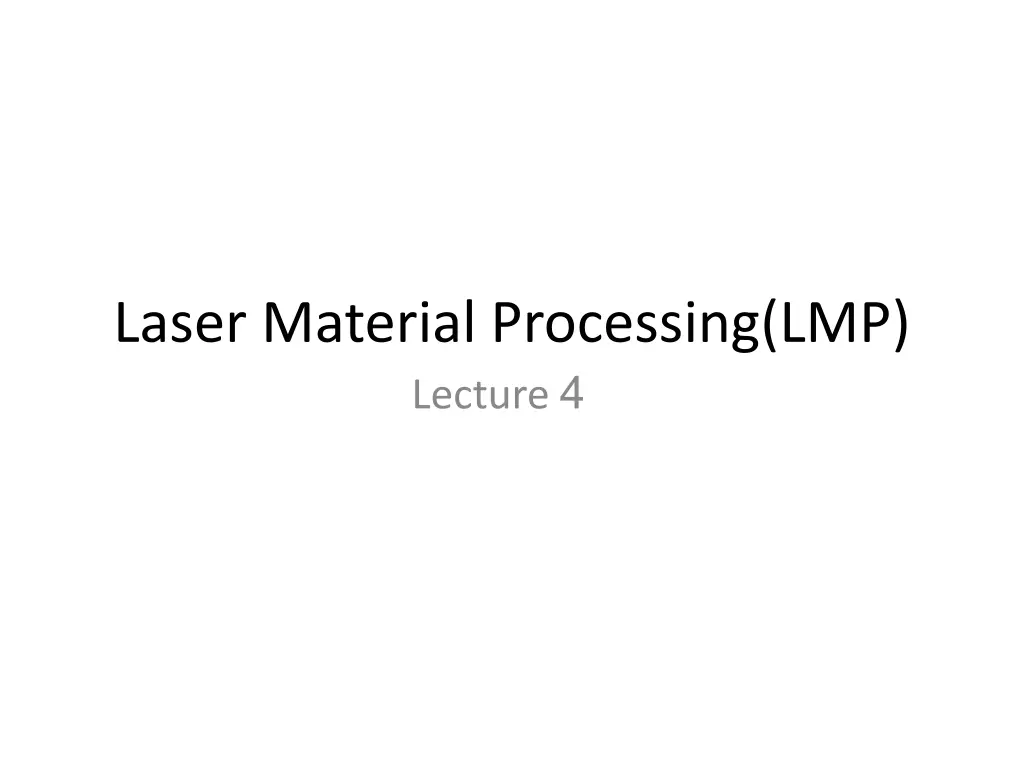
Laser Material Interaction Insights
Explore how laser energy interacts with different materials, including absorption, reflection, and transmission. Learn about factors such as material type, temperature, and surface conditions that influence laser-material interactions. Discover the significance of light parameters and how they affect absorption efficiency. Enhance your understanding of laser processing techniques for optimal results.
Download Presentation

Please find below an Image/Link to download the presentation.
The content on the website is provided AS IS for your information and personal use only. It may not be sold, licensed, or shared on other websites without obtaining consent from the author. If you encounter any issues during the download, it is possible that the publisher has removed the file from their server.
You are allowed to download the files provided on this website for personal or commercial use, subject to the condition that they are used lawfully. All files are the property of their respective owners.
The content on the website is provided AS IS for your information and personal use only. It may not be sold, licensed, or shared on other websites without obtaining consent from the author.
E N D
Presentation Transcript
Laser Material Processing(LMP) Lecture 4
Conclusions Remarks -From pervious lecture we can conclude that: Combination of laser power density and interaction time can produce different types of laser material processing involving either no (only heating) or change of state (melting or vaporization).
Laser material interaction -When a laser beam strikes on the target material, part of the energy is reflected R , part of the energy is transmitted T and part of it is absorbed A. -The effective energy is the portion of energy actually absorbed by the target -The relation for surface absorption of laser energy is: A =1 - R -T - Where A is the surface absorptivity, R is reflection, and T is transmission. -For opaque material( e.g. metals ), T = 0, then A = 1- R
Laser material interaction The predominate phenomena A or T or R depends on: -Material type, -Its temperature, -Surface conditions, and -Light parameters.
Laser material interaction -Material type For example, the values of thermal diffusivity for Al and Ti, are 0.91 and 0.092 cm2/sec, respectively, thus Al will dissipate heat from the treated area at a rate approximately 10 times than that of Ti -Its temperature, With temperature increase the laser-electron energy exchanges increase and thus absorptivity increases see Fig. below. Remember that for metals A = 1- R Fig. Reflectivity vs. temperature for different metals
Laser material interaction -Actually absorption increases from less than 5% as a solid metal to more than 95%, with temperature increases from room temperature to boiling temperature of the material. -Preheating the surface of material improves its absorptivity , thus enhancing laser coupling and interaction. -Surface conditions -Surface conditions have important role in absorption of the incident beam, thin layers of oxides increase the absorptivity, -Increase roughness of the surface, can enhance its absorptivity, -If the roughness of the surface is less than the beam wavelength the surface is considered as flat.
Laser material interaction -Light parameters. -Shorter laser wavelength consider advantage, because it is absorbed more efficiently by materials(less reflected by surface), where the laser photons are more energetic and therefore can be absorbed by more electrons see Fig. below For example, copper has an absorptivity of 2 percent for CO2 lasers (Wavelength = 10.6 um), but it has much higher absorptivity for UV lasers (Wavelength = 0.2 um) (about 60 percent) Remember that for metals A = 1- R Fig. Reflectance vs. wavelength for different metals
Laser material interaction -In material processing, The laser energy is absorbed by free electrons first as illustrated by Fig. below -The absorbed energy TL propagates through the electron subsystem Te , and then is transferred to the lattice ions Ti . Fig. Laser energy absorption by target material. -In this way laser energy is transferred to the ambient target material.
Laser material interaction -The conversion of the absorbed energy TL to heat in metals involves: -(a) excitation of free electrons in metals (Te), -(b) excited electron (Te) gives up this energy through collisions with metal wave lattice (phonon Ti ) within a time of 10 11 to10 12 s, (c) electron (Te ) collides with other electrons (Te of another close atom) .
Laser beam delivery systems Laser Generation mediumtarget material
Laser beam delivery systems -Laser beam can be transferred from the generation medium to the target material by tow ways: 1- Optics, such as driven mirrors reflect/deflect the laser beam onto the desired location on the target
Laser beam delivery systems -Laser beam can be transferred from the generation medium to the target material by tow ways: 2- Fiber waveguide: Laser beam is coupled into the fiber or the flexible waveguide, ,
